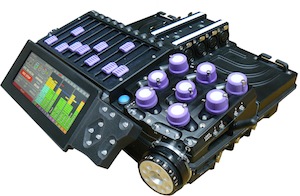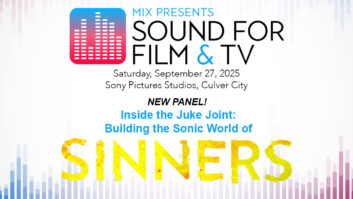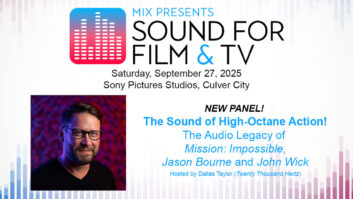
Location recorders have long been a staple of the film industry, all the way back to Stefan Kudelski’s introduction of the Nagra portable tape recorder in 1951—providing a compact, straightforward solution for capturing high-quality audio in the moment with the ability to interface with other essential audio and video devices. Mix surveys the world of portable recorders designed for capturing dialog and sound effects out in the field, or on-set, for professional-level film and video projects. Here, we present a sampling of these products, including 2-channel and multichannel units, ranging from proven, trusted and familiar models to some newer offerings.
Aaton Cantar-X3
Aaton’s Cantar-X3 follows in the footsteps of its predecessor, the Cantar-X2, having been designed by the same team. Cantar-X3 inherits the ergonomics of the X2 and its microphone preamplifiers, which have been redesigned to improve filtering possibilities and reduce the noise level. It also offers Audinate Dante IP networking as an option, and a display-based menu control that was designed by Transvideo, a designer and manufacturer of LCD flat-panel monitors in France. The Cantar-X3 is further optimized for location work due its avionics aluminum machined housing and its military grade water- and dust-proof durable coating. The Cantar-X3 features extended linear faders, smooth rotary knobs and silent switches.
Fostex FR-2LE

Manufactured from high-grade materials and specifically designed for professional location recording, the Fostex FR-2LE records 24-bit/96kHz BWF files, as well as MP3 files, to a Type II CompactFlash card. On an 8GB CF card, it can record 12 hours at 16-bit/44.1kHz. The FR-2LE is equipped with two phantom-powered XLR microphone inputs (XLR-phone combo) complete with precise control over the recording level, as well as high-quality microphone preamps and trim control. Analog out is offered on RCA connectors. It features a 1 take = 1 file recording system to eliminate overwrites, and it has a 2-second pre-record buffer.
Nagra Seven

The Seven is a 2-channel, 24-bit digital recorder fitted with an internal 16GB micro SD flash memory, equipped with AES-42 facilities for digital microphones and offering sampling frequencies up to 192 kHz. It offers a selection of internal optional circuit cards that allow it to be adapted to 3G and Wi-Fi, SMPTE/EBU timecode or ISDN communication. In addition, there are software options for internal audio editing and audio compression (MPEG). The Seven offers two analog audio inputs and a single stereo digital input. It will record in PCM linear audio at sampling frequencies up to 192 kHz or in MPEG-1 layer II compressed audio formats if the compression option is installed. The inputs are equipped with traditional Nagra mic preamps for dynamic and phantom-powered microphones, and offer switchable sensitivity settings. The analog line input will accept up to +24 dB.
Roland R-88

The Roland R-88 includes various timecode modes and slate tone/mic for memos. The stereo mix output on the R-88 is designed for location sound recording applications enabling a stereo mix back to the camera to record reference audio, or providing a stereo monitor output while simultaneously recording individual tracks. With eight discrete outputs users can also embed the audio tracks into a SDI video feed by using a multichannel SDI audio embedding device. The R-88 also offers AES/EBU digital I/O to digitally record from or send to a mixing console or other digital source. The R-88’s built-in mixer is equipped with a 3-band EQ enabling a stereo mix to be monitored or recorded simultaneously along with each discrete audio track. The R-88 has a built-in 10-input/8-output USB audio interface for multichannel recording.
Sony PCM-D100

The PCM-D100 is a high-resolution recorder with two-position (X/Y or Wide) electret condenser microphones, 32 GB of internal flash memory and a SD-XC Card slot. Recording formats include linear PCM (at 192, 176.4, 96, 88.2, 48 and 44.1 kHz); DSD (2.8224 MHz) and MP3 (320 and 128 kbps). Additional playback support is provided for FLAC, WMA and AAC files. The PCM-D100 offers comprehensive signal processing features for location recording including a limiter and low-cut filter. The PCM-D100 also includes a 5-second pre-record buffer and cross-memory recording function. The PCM-D100 is constructed of lightweight aluminum and uses conventional AA alkaline batteries. The recorder includes a USB high-speed port, digital pitch control, dual path digital limiter, Super Bit Mapping and A-B repeating capability.
Sound Devices 970

Sound Devices’ half-rack, 2U model 970 records 64 channels of monophonic or polyphonic 24-bit/48kHz WAV files. Connections include 64 channels of Ethernet-based Dante, 64 channels of optical or coaxial MADI, eight channels of line-level analog and eight channels of AES digital. Any input can be assigned to any track, and it supports 32-track recording at 96 kHz. The 970 records to any of four attached drives: two front panel drive bays and two rear panel e-SATA connected drives. With four available drives, material can be recorded to multiple drives simultaneously for backups. Drives can also be set to record sequentially, allowing continuous long form, high-track count recordings. The 970’s built-in Ambient timecode generator allows it to operate as either the master clock or be jammed to external devices cameras and other sources. All common production timecode rates and modes are supported.
Tascam HS-P82

Tascam’s 8-track solid-state HS-P82 has eight microphone inputs (plus an internal slate microphone for naming takes), SMPTE timecode in and out, video and word sync, and a color touchscreen interface. The standard XLR microphone inputs include phantom power and analog limiting, with mic and line-level trims controlled from recessed front-panel controls. A set of AES/EBU connectors is available for attaching pedigree A/D converters and preamplifiers. In addition, the HS-P82 can record a stereo mixdown for instant use. Audio is recorded at up to 192kHz/24-bit WAV format to a pair of Compact Flash cards, and users can record to both cards simultaneously. The Broadcast WAV files include iXML metadata for quick import into nearly any video or audio editing system, either via the USB 2 connection or a standard card reader. The HS-P82 further includes mid/side decoding.
Zaxcom Maxx

The Zax-Maxx offers six analog inputs: four with mic preamps featuring NeverClip—which uses A/D converters per transmitter or recorder to generate 123dB of dynamic range—and two AES digital inputs that can be used with AES42 microphones. Each input channel has a highpass filter, two variable notch filters, variable delay and a soft-knee compressor. All inputs can be mixed into a 2-channel output bus over two sets of output connectors that can be individually configured as line, mic and consumer output levels, as well as a balanced mono and tape out. There are four AES direct outs and an AES stereo mix. The 2-channel balanced camera returns double as balanced line level inputs. Maxx comes standard with the ability to record eight tracks on a CompactFlash card. Files can be recorded at up to 24-bit/192 kHz with a dynamic range of 137 dB.
Zoom H6 Handy Recorder

Zoom’s flagship H6 6-track recorder records WAV and MP3 files directly to SD cards and supports SDHC and SDXC cards with up to 128 GB. It can record up to six monophonic WAV files (or up to three stereo files) in up to 24-bit/96kHz formats. All WAV files are Broadcast Wave Format (BWF) compliant. The H6 has four main inputs (1-4) plus two additional inputs (L, R) that are derived from five interchangeable capsules: X/Y, M/S, shotgun or dual XLR/TRS combo. The XYH-6 X/Y capsule also provides a secondary input for connecting an external mic- or line-level signal via a stereo 1/2-inch Mic/Line In mini phone jack. Inputs 1-4 are combo connectors that can accept either XLR or ¼-inch balanced or unbalanced phone cables, and can handle both mic- and line-level signals. Each input has a dedicated gain control knob as well as a -20dB pad. [Editor’s Note—Zoom recently introduced the H5; for information, go to New Products on page 66.]







